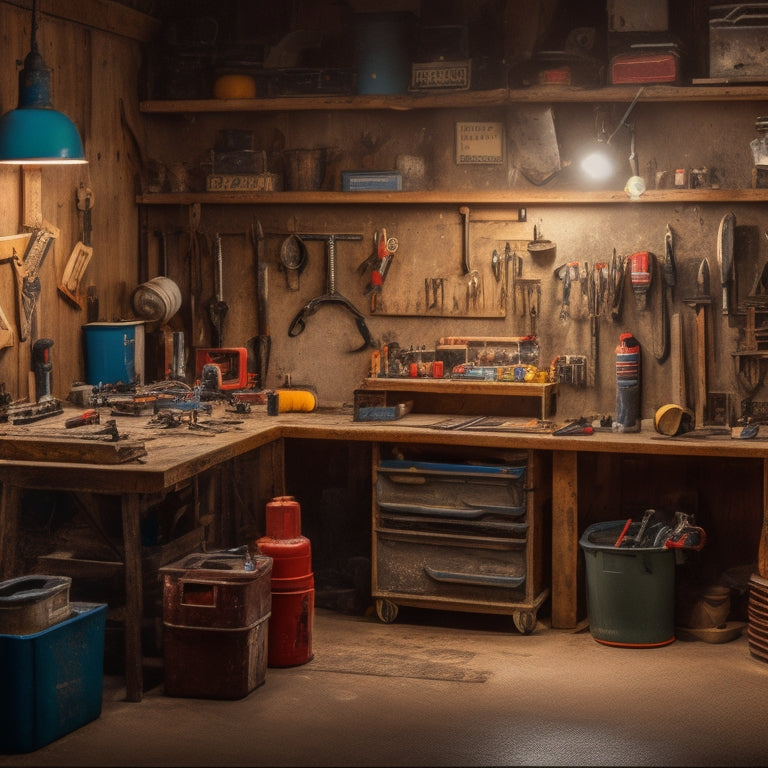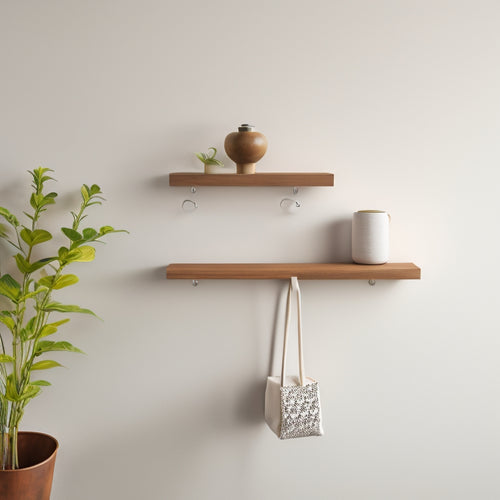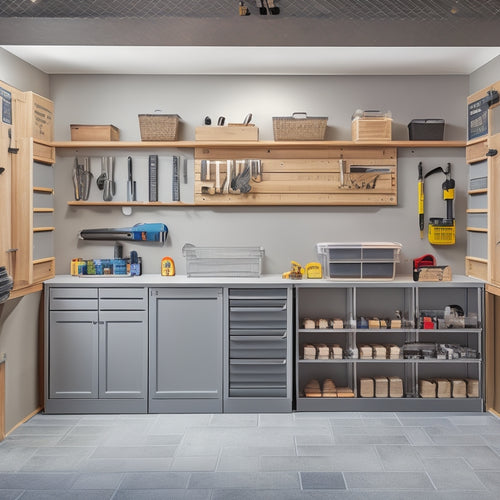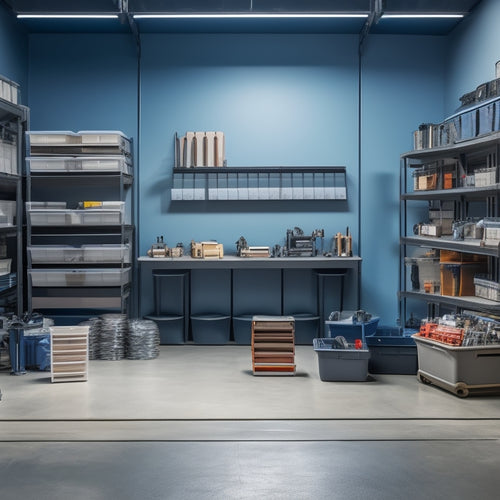
What's Holding You Back From Organized Tool Storage?
Share
You're stuck in a cluttered and disorganized workspace because one or more of four common obstacles are holding you back. Limited space in your garage or workshop might be crowding out your tools, or you might be lacking adequate storage solutions to keep them organized. Maybe you're wasting time searching for the right tools, or struggling to customize a solution that fits your unique needs and budget. Whatever the challenge, it's preventing you from achieving the organized tool storage you need to maximize your productivity. Identify the root of the problem and you'll be one step closer to a streamlined workspace that boosts your efficiency.
Key Takeaways
• Limited garage space and inadequate tool storage solutions can lead to clutter and disorganization, hindering productivity.
• Difficulty in finding the right tools due to disorganization can result in wasted time and decreased efficiency.
• Customization challenges and costs can be a barrier to creating an organized tool storage system that meets specific needs.
• Fear of wasting time and money, lack of inspiration and ideas, and uncertainty about measuring tools can hold people back from organizing their tool storage.
• Inaccurate measurements and planning can lead to costly mistakes and ineffective tool storage solutions.
Limited Space in Your Garage
You're likely no stranger to the frustration of cluttered garage floors and overflowing shelves, where every square foot is precious real estate. It's time to face the music: your garage has become a storage nightmare. It's hard to find what you need, and it's even harder to fit everything in. But don't worry, you're not alone. Many homeowners struggle with limited space in their garages.
The first step to tackling this issue is to perform a garage purge. Get rid of anything you no longer need or use. Be ruthless – if you haven't used it in the past year, it's probably safe to let it go.
Once you've decluttered, it's time to think outside the box (or garage, in this case). Look for space hacks that can help you maximize your garage's storage potential. Consider installing shelves or hooks to keep items off the floor and out of the way.
You can also use bins and containers to keep similar items together and organized. With a little creativity and elbow grease, you can turn your garage from a cluttered mess into a functional and efficient space.
Inadequate Tool Storage Solutions
Now that your garage is decluttered and organized, it's time to tackle the next hurdle: finding a suitable home for your tools, which are likely scattered throughout the garage or stuffed into overcrowded toolboxes. You're probably feeling frustrated with the current state of your tool storage, and it's holding you back from achieving true organization.
Tool overload is a real issue, and it's causing you storage anxiety. You know you need a better system, but you're not sure where to start. You've tried using bins and baskets, but they're not doing the trick. Your tools are still hard to find, and you're wasting valuable time searching for them.
It's time to think outside the toolbox. Consider investing in a pegboard or slatwall system, which will give you the flexibility to customize your storage to fit your specific needs. You can also use stackable containers or a tool chest with dividers to keep your tools organized and within reach.
Don't let inadequate tool storage solutions hold you back any longer. Take control of your tools and start enjoying the benefits of organized tool storage.
Difficulty in Finding the Right Tools
When you need a specific tool, you don't want to waste time searching for it. You've likely experienced the frustration of rummaging through a cluttered toolbox or workshop, only to come up empty-handed.
It's time to acknowledge that the difficulty in finding the right tools is a significant obstacle to your productivity.
Lost in the Chaos
Amidst the disarray of your workspace, precious minutes tick away as you frantically search for that one essential tool, only to find it buried beneath a pile of clutter or misplaced in a forgotten corner. You're not alone in this struggle. Many of us have experienced the frustration of a cluttered workshop, where tools are scattered everywhere, making it impossible to find what you need when you need it.
Overflowing shelves and workbenches contribute to the chaos, making it difficult to locate a specific tool. You might find yourself wasting valuable time searching for a wrench or screwdriver, only to realize it was right in front of you the whole time. This not only slows down your work but also increases your stress levels.
You know you're capable of producing quality work, but your disorganized workspace is holding you back. It's time to take control of your tools and create a system that works for you. By implementing an organized tool storage system, you can regain those precious minutes and focus on what matters most – getting the job done efficiently and effectively.
Toolbox Treasure Hunt
You've wasted countless hours digging through your toolbox, only to find that the one tool you need is buried at the bottom of a jumbled mess of wrenches, pliers, and screwdrivers. It's a frustrating experience that's all too familiar. You're not alone in this struggle. Many of us have fallen victim to toolbox archaeology, rummaging through our tools like an archaeologist searching for lost artifacts.
But what if you could put an end to this treasure hunt? Imagine having a clear map of your toolbox, where every tool has its designated spot. It's not a pipe dream; it's a reality that's within your reach. By organizing your tools in a logical and methodical way, you can save time and reduce stress. You'll no longer have to dig through your toolbox like a treasure hunter, searching for that one elusive tool. Instead, you'll know exactly where to find it.
With a well-organized toolbox, you can focus on the task at hand, rather than wasting time searching for the right tool. It's time to put an end to the toolbox treasure hunt and start working more efficiently.
Hunting for Hidden Tools
As you're well aware, the toolbox treasure hunt often stems from a bigger issue: tools are frequently misplaced or hidden from view, making it difficult to find the right one when you need it most. You've probably spent hours searching for that one specific wrench or screwdriver, only to find it buried beneath a pile of other tools or tucked away in a hidden corner. This is what we call Tool Blindspots - areas in your toolbox where tools tend to disappear from sight.
When you're in the midst of a project, the last thing you need is to waste time hunting for a tool that's supposed to be right at your fingertips. It's frustrating, and it slows you down. But the truth is, most of us have Tool Blindspots in our workspaces. It might be that top shelf you can't quite reach, or the drawer that's always jammed.
Whatever it is, it's time to shine a light on those Hidden Corners and get your tools organized once and for all. By doing so, you'll save time, reduce stress, and get back to what matters most - getting the job done.
Customization Challenges and Costs
How much are you willing to invest in a customized tool storage system that meets your unique needs and preferences?
You know your tool collection better than anyone, and a tailored solution can make all the difference in maximizing your workspace efficiency. However, customization comes with its own set of challenges and costs.
Some common hurdles to take into account are:
-
Budget constraints: Customized solutions can be pricey, and it's important to weigh the costs against the benefits.
-
Design limitations: You may have a clear vision, but it mightn't be feasible due to space or material constraints.
-
Measuring and planning: Accurate measurements and thorough planning are important to ensure a seamless integration.
-
Material sourcing: Locating the right materials that fit your design and budget can be a time-consuming process.
-
Assembly and installation: You'll need to take into account the time and effort required to assemble and install your custom system.
Digital Plans for Custom Tool Storage
When creating digital plans for custom tool storage, you'll need to focus on three key points.
You'll start by designing your layout around the specific tools you need to store, ensuring each one has a precise spot.
Then, you'll measure the available space to maximize efficiency and customize your storage for best workflow.
Designing for Specific Tools
You'll maximize the effectiveness of your tool storage system by designing custom spaces for your most frequently used tools, guaranteeing they're always within easy reach and minimizing clutter. To achieve this, you'll need to create a digital plan that takes into account the unique characteristics of each tool. This is where tool profiling comes in – it's the process of documenting the size, shape, and storage requirements of each tool.
Here are some key considerations to keep in mind when designing custom spaces for your tools:
-
Tool height and width: Make sure your storage spaces are tailored to the exact dimensions of each tool, leaving no wasted space.
-
Zone allocation: Divide your storage area into zones, each dedicated to a specific type of tool or task, to improve workflow and reduce searching time.
-
Tool handles and grips: Design storage spaces that accommodate the handles and grips of your tools, making them easy to grab and go.
-
Cable and cord management: Plan for storage solutions that keep cables and cords organized and untangled.
-
Weight distribution: Consider the weight of your tools and design storage spaces that distribute weight evenly, preventing damage or strain on the storage system.
Measuring Available Space
Before designing custom storage spaces for your tools, measure the available space in your workshop or garage to determine the maximum dimensions of your storage system. This important step helps you avoid costly measurement mistakes and guarantees your storage system fits comfortably in the allotted space.
Take note of any space constraints, such as pillars, windows, or doors, that may impact your storage design. Measure the width, height, and depth of the available space, as well as any obstructions.
Here's a quick checklist to get you started:
| Measurement | Description |
|---|---|
| Width | Distance between walls or pillars |
| Height | Distance from floor to ceiling or overhead obstructions |
| Depth | Distance from wall to front of storage system |
| Obstructions | Note any windows, doors, or pillars that may impact design |
| Clearance | Make sure enough space for easy access and tool retrieval |
Customizing for Efficiency
With your workshop's dimensions in hand, you can now design a custom storage system that maximizes efficiency and streamlines your workflow. This is where you get to think creatively about how you want to organize your tools and materials. You'll want to take into account the tools you use most frequently and how you can position them for easy access.
Here are some ideas to get you started:
-
Zone-specific storage: Designate specific areas for tasks like woodworking, metalworking, or assembly
-
Task-oriented stations: Create dedicated stations for activities like drilling, sawing, or sanding
-
Height-based storage: Store less frequently used items on higher shelves, and keep frequently used items at eye level
-
Mobile storage: Incorporate carts or bins with wheels to move tools and materials around the workshop
-
Labeling and signage: Clearly label each storage area and station to make sure you can quickly find what you need
Fear of Wasting Time and Money
Fear of wasting time and money on a tool storage system that doesn't meet your needs can be a major obstacle to getting organized. You're worried that you'll invest hours of your precious time and hard-earned cash into a system that won't deliver. This fear is valid, especially when you're already dealing with Time Constraints.
You've got a lot on your plate, and the last thing you want is to sink more time into a project that won't pay off. Financial Anxiety is also a significant concern. You've got a budget to stick to, and you can't afford to waste money on a system that won't work for you. The thought of throwing money at a problem without getting the results you need is challenging.
But here's the thing: investing in a well-planned tool storage system can actually save you time and money in the long run. By streamlining your workflow and reducing waste, you'll be more productive and efficient. So, take a deep breath and start exploring your options.
With a little planning and research, you can create a tool storage system that meets your needs and sets you up for success.
Lack of Inspiration and Ideas
You've overcome your fears of wasting time and money, and now you're ready to tackle the next hurdle: finding the inspiration and ideas to create a tool storage system that truly works for you. This is where many people get stuck, feeling overwhelmed by the sheer possibilities. But fear not, we've your back.
To get started, try:
-
Browsing Pinterest for tool storage ideas and saving the ones that resonate with you
-
Conducting online research to see what other DIY enthusiasts and professionals have done
-
Taking inventory of your tools and categorizing them by type and frequency of use
-
Measuring your available storage space to determine the maximum size of your system
-
Sketching out rough designs and layouts to visualize your plans
Uncertainty About Measuring Tools
Measuring your tools accurately is essential for creating a storage system that maximizes space and efficiency, so take the time to gather the necessary measuring tools and learn how to use them effectively. You'll need a tape measure, calipers, or a ruler to get accurate readings. Don't assume you can eyeball it – measurement mistakes can lead to a storage system that's inefficient or even unusable.
To avoid mistakes, always double-check your measurements. Take your time, and make sure you're using the correct unit of measurement.
It's also crucial to take into account the size and shape of your tools when measuring. For example, if you're measuring a wrench, you'll need to account for its length, width, and any irregular shapes.
Frequently Asked Questions
How Do I Store Tools With Odd Shapes and Sizes Effectively?
You tackle tool storage challenges by designing custom inserts or utilizing adjustable compartments that adapt to odd shapes and sizes, ensuring a snug, organized fit that maximizes your storage space and reduces clutter.
Can I Use Existing Furniture for Tool Storage Organization?
"Think of your existing furniture as a blank canvas, waiting for your creative brushstrokes. You can repurpose shelving and hack furniture to create a tailored tool storage system, breathing new life into old pieces and making organization a breeze."
Are There Tool Storage Solutions for Small Workshops or Sheds?
You'll find plenty of tool storage solutions for small workshops or sheds, focusing on compact layouts and space savers like wall-mounted pegboards, foldable workbenches, and stackable bins that maximize your limited space efficiently.
How Can I Store Tools in a Way That's Accessible to Everyone?
You'll achieve accessible tool storage by implementing a clear labeling system, assigning shared responsibility, and designating specific zones for each tool type, ensuring everyone can easily find and return tools.
Are Tool Storage Systems Easy to Move or Reconfigure?
"Remember the last time you struggled to move a heavy toolbox? Modular designs and portable options make it easy to reconfigure your tool storage, allowing you to take control and adapt to changing needs, effortlessly."
Related Posts
-

Wall Mounted Hooks With Shelf for Maximum Storage
You'll find that wall mounted hooks with a shelf are a revolutionary solution for maximizing storage in your home, pr...
-

Essential Steps for Garage Storage System Design
You're about to change your cluttered garage into an organized haven by following a structured approach to garage sto...
-

How to Maximize Storage Space With Parts Storage Bins
To maximize storage space with parts storage bins, start by evaluating your available storage space and examining you...


